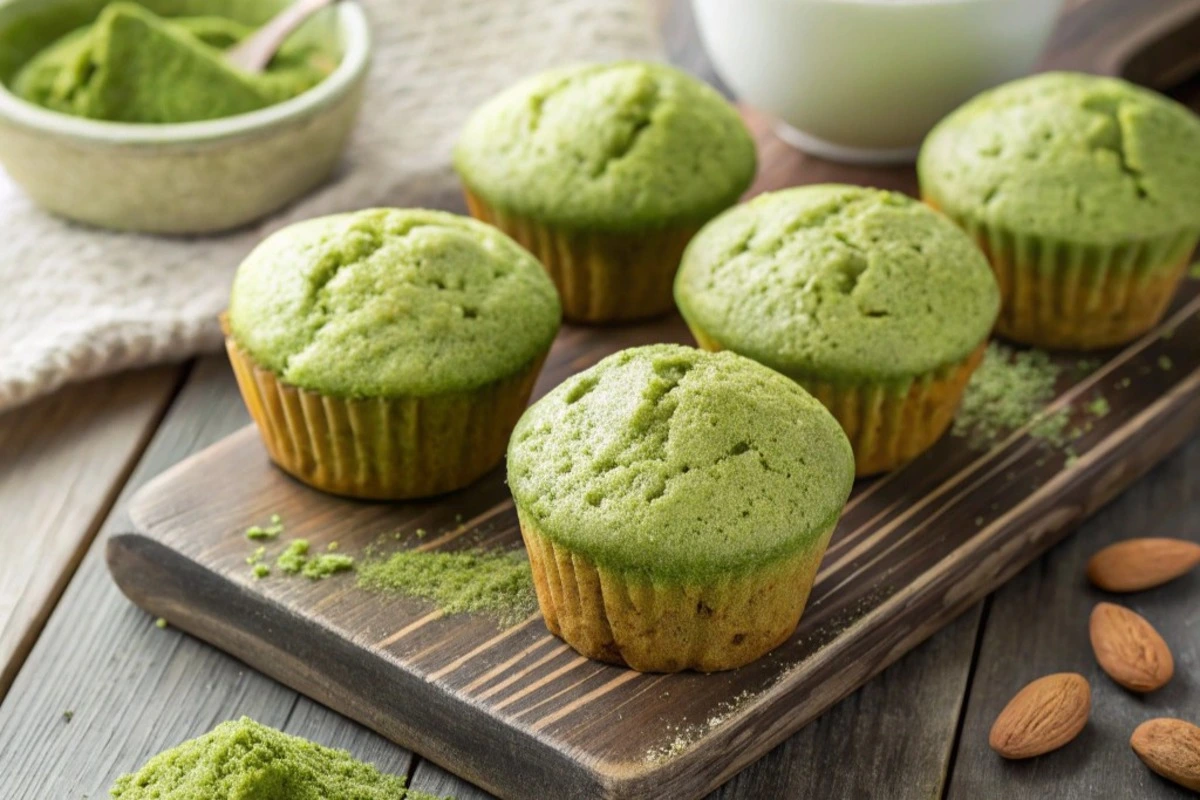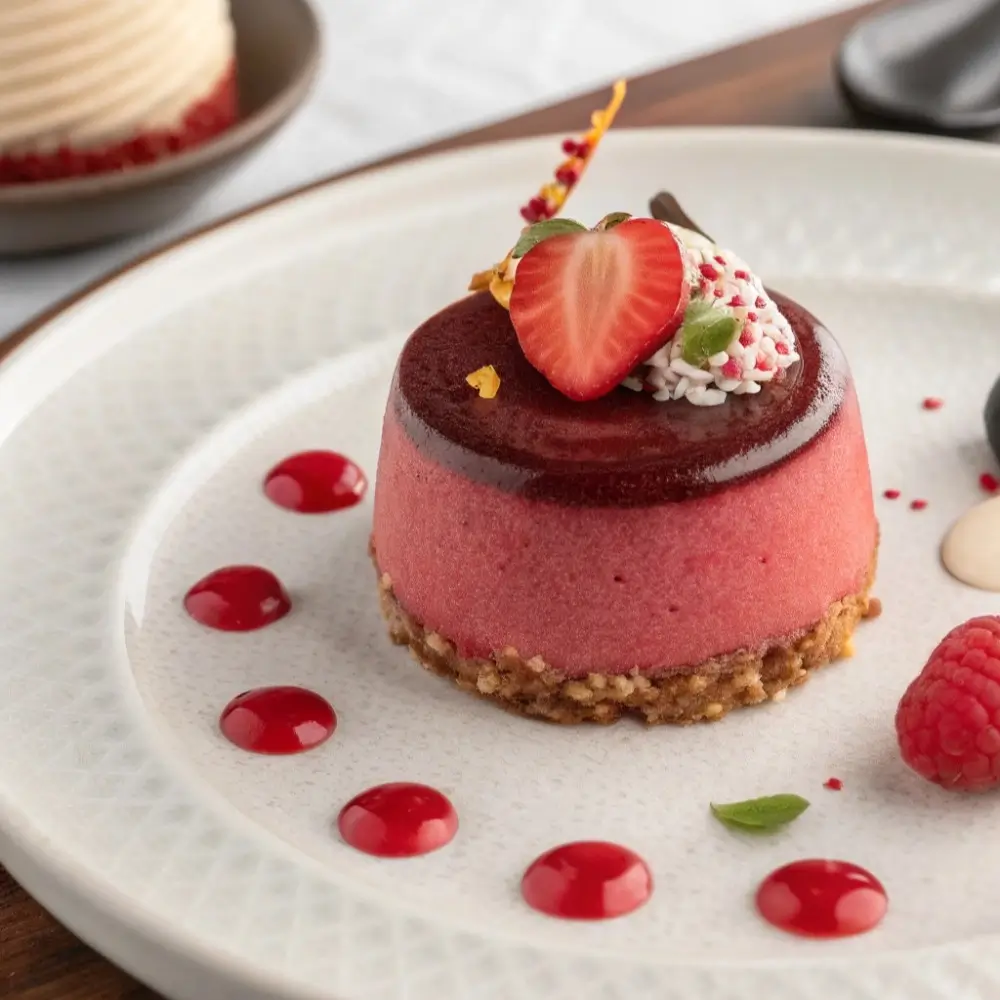Table of Contents
- 1 Ingredients for Matcha Muffin Recipe with Almond Flour
- 2 How to Make Matcha Muffin with Almond Flour Recipe
- 3 Health Benefits of Matcha and Almond Flour
- 4 Customizing Your Matcha Muffin Recipe with Almond Flour
- 5 FAQs about Matcha Muffin Recipe with Almond Flour
- 6 Health Benefits of Almond Flour and Matcha
Introduction to the Matcha Muffin Recipe with Almond Flour
If you’re someone who loves to bake but also wants to make healthier choices, you’re in the right place. We’re diving into a fantastic recipe that combines the delicate flavors of matcha and the rich texture of almond flour, creating muffins that are not only delicious but also nutritious. Whether you’re following a gluten-free, low-carb, or keto diet, this matcha muffin recipe with almond flour are a perfect treat. And hey, you don’t have to be a baking expert to make them! With just a few ingredients and a little bit of patience, you’ll be able to whip up a batch of moist, flavorful muffins that’ll satisfy your sweet tooth without compromising your health.
Ingredients for Matcha Muffin Recipe with Almond Flour
Let’s start by talking about the ingredients that make these matcha muffins so special. You’ll need some basic staples, but it’s the unique combination of matcha and almond flour that sets this recipe apart.
Matcha Powder – What to Look For and Best Brands
First up, the matcha powder—the star of the show. Matcha is finely ground green tea leaves that are packed with antioxidants. The better the quality, the richer the flavor. Look for ceremonial grade matcha for the best taste, but if you’re on a budget, culinary-grade matcha will also work just fine. Brands like Encha or Ippodo offer high-quality matcha that will bring the perfect vibrant green color and earthy flavor to your muffins.
Almond Flour – Why It’s Preferred in This Recipe
Next, we have almond flour, which serves as the base of these gluten-free, low-carb muffins. Unlike regular flour, almond flour is made from finely ground almonds, making it naturally grain-free. It provides a wonderful nutty flavor and a moist texture that regular flour just can’t match. Not only does almond flour support a healthier muffin, but it also adds a boost of protein and healthy fats, making these muffins a filling and satisfying snack or breakfast option.
Sweetener – Options for Keto or Healthy Sweeteners
For sweetness, there are several options depending on your dietary preference. If you’re following a keto or low-carb diet, sweeteners like erythritol, stevia, or monk fruit sweetener are great choices. They won’t spike your blood sugar, and they’ll still give you that sweet muffin flavor. For a more traditional touch, you can always use honey, maple syrup, or coconut sugar, but keep in mind that these will add some carbs to the recipe.
Eggs – Their Role in Structure and Texture
No muffin recipe is complete without eggs! They help to bind all the ingredients together and provide a fluffy, tender texture. The eggs also contribute to the muffins’ rise as they act as a leavening agent when mixed with baking powder.
Baking Powder – The Importance for Fluffiness
Speaking of baking powder, you’ll need it for that extra lift. It reacts with the wet ingredients to create air pockets, helping the muffins rise beautifully in the oven. Without it, your matcha muffins might turn out flat and dense—definitely not what you want.
Vanilla Extract – For Flavor Enhancement
A splash of vanilla extract adds depth and rounds out the flavors in these muffins. It complements the matcha while not overpowering it. You can always opt for almond extract if you want to add another layer of flavor!
Butter or Coconut Oil – For Moisture and Richness
For moisture, you’ll be using either butter or coconut oil. Butter adds richness and a lovely buttery flavor, while coconut oil gives a slight tropical vibe and is perfect if you’re aiming for a dairy-free muffin. Both options will ensure that your muffins stay soft and moist without turning dry or crumbly.
Optional Add-ins – Chocolate Chips, Nuts, or Berries
Now, here’s the fun part! You can easily customize your matcha muffins by adding your favorite mix-ins. Try tossing in some chocolate chips, chopped almonds, or blueberries for an added burst of flavor. Just remember to fold them gently into the batter to prevent over-mixing.
Optional Ingredients for Customization
While the basic recipe is delicious on its own, here are some ideas for switching it up:
Matcha Coconut Muffins
If you’re a fan of coconut, adding shredded coconut to the batter will give your muffins an extra tropical flair.
Matcha Chocolate Chip Muffins
For a little indulgence, add some dark chocolate chips to the mix. The bitterness of the chocolate balances perfectly with the earthy matcha flavor.
Matcha Berry Muffins
Try adding raspberries or blueberries for a fruity touch that pairs wonderfully with the matcha’s deep flavor. Just make sure to use fresh or frozen berries—don’t go for canned, as they could make the batter too soggy.
How to Make Matcha Muffin with Almond Flour Recipe
Step-by-Step Instructions for Perfect Matcha Muffins
Now that we have all the ingredients, let’s dive into the process of making these delicious and nutritious matcha muffins. Don’t worry—this recipe is simple and easy to follow. Just a few steps, and you’ll have freshly baked muffins in no time.
Preheat the Oven
Start by preheating your oven to 350°F (175°C). This ensures that the muffins bake evenly and rise properly once the batter is ready. While the oven heats up, you can prepare the muffin tin.
Prepare the Muffin Tin
Line a 12-cup muffin tin with paper liners or lightly grease each cup with butter or coconut oil. This helps prevent the muffins from sticking to the pan and makes cleanup a breeze. If you’re using a silicone muffin pan, no greasing is needed!
Mix the Dry Ingredients
In a medium-sized mixing bowl, whisk together the almond flour, baking powder, and matcha powder. Make sure the matcha powder is fully incorporated into the dry ingredients. This step is crucial, as you want the matcha evenly spread throughout the muffins. You can also add in any optional dry ingredients here, like shredded coconut or chopped almonds.
Whisk the Wet Ingredients
In another bowl, whisk the eggs, vanilla extract, and melted butter or coconut oil together. Then, add your sweetener of choice—whether it’s erythritol, monk fruit, or honey. Mix well until everything is fully incorporated. If you’re using a liquid sweetener like maple syrup, reduce the amount of other wet ingredients slightly to maintain the right batter consistency.
Combine Wet and Dry Ingredients
Pour the wet ingredients into the bowl with the dry ingredients. Stir gently with a spatula or spoon until just combined. Be careful not to over-mix, as this can result in dense muffins. The batter should be thick but smooth.
Optional Mix-ins
At this point, you can fold in any optional mix-ins like dark chocolate chips, blueberries, or chopped nuts. Just gently fold them in with a spatula, ensuring they’re evenly distributed without overworking the batter.
Baking the Muffins
Baking Time and Temperature
Scoop the batter into the prepared muffin tin, filling each cup about 2/3 of the way full. This allows the muffins to rise without overflowing. Pop the tray into the oven and bake for about 20–25 minutes, or until a toothpick inserted into the center of a muffin comes out clean. The matcha muffins should be golden brown on top and spring back slightly when touched.
Letting the Muffins Cool
Once baked, remove the muffins from the oven and let them cool in the pan for 5 minutes. Then, transfer them to a wire rack to cool completely. This cooling step is essential, as it allows the muffins to firm up and achieve their perfect texture.
Storing Your Matcha Muffins
Storing Leftovers
These matcha muffins are best enjoyed fresh, but if you have leftovers, don’t worry—they store well! To keep them fresh, place the muffins in an airtight container. You can store them at room temperature for up to 2–3 days. If you want them to last longer, keep them in the refrigerator, where they will stay fresh for up to a week.
Freezing the Muffins
Want to make a batch in advance? These muffins freeze beautifully! Allow the muffins to cool completely, then wrap each muffin tightly in plastic wrap or aluminum foil. Place them in a freezer-safe bag or container. They will keep for up to 2 months. When you’re ready to eat, just reheat them in the microwave or oven for a few minutes to enjoy them warm.
Health Benefits of Matcha and Almond Flour
Nutritional Benefits of Matcha
Matcha is more than just a trendy ingredient—it’s packed with a ton of health benefits that make these muffins even better for you! Let’s explore why matcha is a superfood worth incorporating into your diet.
Rich in Antioxidants
One of the main benefits of matcha is its high antioxidant content. Matcha is rich in catechins, a type of antioxidant that helps protect your cells from damage caused by free radicals. These antioxidants help support overall health and well-being.
Boosts Energy and Focus
Matcha contains a natural caffeine source that provides a gentle, sustained energy boost without the jittery side effects that come with coffee. The L-theanine in matcha also helps promote relaxation and focus, making it an ideal ingredient for those who want to stay energized but calm.
Supports Detoxification
Matcha helps to support the body’s natural detoxification process. The chlorophyll found in matcha assists in eliminating toxins and impurities from the body, contributing to better overall health.
Helps with Metabolism
Drinking matcha can boost your metabolism, which can be helpful if you’re looking to manage your weight. Including matcha in your baked goods, like these matcha muffins, allows you to enjoy its benefits in a delicious form.
Why Almond Flour is a Great Choice
Almond flour is another powerhouse ingredient in these muffins. Let’s look at the reasons why almond flour is not only a tasty choice but also a healthy one.
Gluten-Free and Low-Carb
Almond flour is naturally gluten-free, making it perfect for those following a gluten-free diet. It’s also low in carbs, which makes it a great option for keto or low-carb diets. This flour is an excellent alternative to regular wheat flour, as it provides a similar texture without the gluten.
Packed with Healthy Fats and Protein
Unlike traditional flour, almond flour is high in healthy fats and protein, which helps keep you full and satisfied. The combination of healthy fats and protein makes these muffins a filling snack or breakfast option that supports sustained energy.
Rich in Vitamin E and Magnesium
Almond flour is an excellent source of vitamin E, an antioxidant that helps protect your cells and supports skin health. It also contains magnesium, which is essential for muscle function, bone health, and energy production.
Check more Gluten-Free Dessert Recipes
Customizing Your Matcha Muffin Recipe with Almond Flour
Add Fun Flavors and Ingredients
Feel free to get creative with your matcha muffins! While the basic recipe is absolutely delicious, you can easily customize it to suit your preferences. Here are some fun ideas to try:
Matcha and Lemon Muffins
Add some fresh lemon zest to your muffins for a citrusy kick that pairs perfectly with the earthiness of matcha. The bright, tangy flavor balances the richness of the almonds and matcha beautifully.
Matcha Chia Seed Muffins
For added texture and nutrients, mix in some chia seeds. They are packed with omega-3 fatty acids, fiber, and protein. They’ll give your muffins an extra nutritional boost while adding a bit of crunch.
Matcha Protein Muffins
If you’re looking for an even more filling snack or breakfast, you can add a scoop of your favorite protein powder to the mix. It’ll make your muffins higher in protein, perfect for post-workout recovery.
These matcha muffins with almond flour are a delicious and healthier twist on a classic treat. If you’re looking for more almond flour recipes, check out this collection of gluten-free almond flour recipes.
FAQs about Matcha Muffin Recipe with Almond Flour
Here, we’ll answer some of the most commonly asked questions about making matcha muffin recipe with almond flour. Whether you’re a seasoned baker or a beginner, we’ve got you covered with some useful tips and tricks to ensure your muffins turn out perfectly every time.
Can I make these matcha muffins without eggs?
Yes, you can! If you’re looking to make an egg-free version of these muffins, you can substitute the eggs with egg replacers like flax eggs or chia eggs. For each egg, use 1 tablespoon of ground flaxseeds or chia seeds mixed with 3 tablespoons of water. Let it sit for a few minutes to thicken before adding it to the batter.
Alternatively, you can use other egg substitutes like applesauce or mashed bananas if you prefer a plant-based option.
Can I use coconut flour instead of almond flour?
Coconut flour is another great gluten-free option, but it behaves quite differently from almond flour. If you want to use coconut flour, you will need to adjust the ratios. Coconut flour is more absorbent, so you’ll need to use less of it—typically about 1/4 cup of coconut flour for every 1 cup of almond flour. You may also need to increase the amount of liquid in the recipe to keep the batter from being too dry.
How can I make these muffins sweeter?
If you have a sweeter tooth or prefer a little extra sweetness in your matcha muffins, feel free to increase the amount of sweetener. Whether you’re using stevia, erythritol, maple syrup, or honey, you can adjust the amount according to your personal taste. Just be mindful not to add too much, as it might affect the muffin’s texture.
If you like, you can also add some chocolate chips or a swirl of nut butter on top for a delicious extra layer of flavor.
Can I substitute the matcha powder for something else?
If you’re not a fan of matcha or simply can’t find any, you can try swapping it with another green powder like spirulina or even moringa powder. Keep in mind that these substitutions will alter the flavor slightly, but they’ll still offer some great health benefits. You could also experiment with adding a bit of cinnamon, ginger, or even cocoa powder for a new twist.
How do I know when my muffins are done baking?
The best way to check if your muffins are done is to insert a toothpick into the center of one of the muffins. If it comes out clean or with just a few crumbs, your muffins are ready. If the toothpick comes out with wet batter, put them back in the oven for a few more minutes. Be sure to check them frequently after the 20-minute mark.
Health Benefits of Almond Flour and Matcha
While we’ve already touched on the benefits of almond flour in this recipe, let’s dive deeper into why almond flour is such a great ingredient for your health.
High in Protein and Healthy Fats
Almond flour is an excellent source of plant-based protein. It’s packed with essential amino acids that help support muscle repair, immune function, and overall growth. Additionally, almond flour is high in healthy fats, including monounsaturated fats, which are heart-healthy and support brain function. It’s the perfect ingredient to keep you feeling full and satisfied throughout the day.
Rich in Vitamin E
Almond flour is a great source of vitamin E, an antioxidant that helps to protect your skin, eyes, and overall health from the damaging effects of free radicals. Vitamin E is also known to support immune health and has anti-inflammatory properties. So not only will these matcha muffins fuel your body, but they’ll also help protect it!
Supports Heart Health
The healthy fats in almond flour help reduce bad cholesterol levels and promote heart health. Almond flour is an excellent choice for those looking to maintain a healthy heart, as it helps lower the risk of cardiovascular diseases. The fiber in almond flour also aids in regulating blood sugar levels, making it ideal for those with diabetes or anyone aiming to stabilize their blood sugar.
The Health Benefits of Matcha
Now that we know how almond flour contributes to a healthy diet, let’s explore the many reasons to love matcha. This powerful green tea powder has been used for centuries in traditional Japanese medicine and offers a range of health benefits.
Boosts Metabolism and Fat Burning
One of the primary benefits of matcha is its ability to boost metabolism. Studies have shown that the antioxidants in matcha, particularly catechins, help accelerate fat burning, making it a great addition to your weight management routine. Consuming matcha in the form of muffins or drinks can help give your metabolism the extra push it needs.
Provides Sustained Energy
Unlike coffee, which can give you a rapid but short-lived energy boost, matcha provides a steady stream of energy. This is due to the combination of caffeine and L-theanine, an amino acid found in matcha. L-theanine promotes a calm and focused state, helping you avoid the jittery feelings often associated with coffee.
Rich in Antioxidants
Matcha is packed with antioxidants that help protect your body from oxidative stress, which can damage cells and lead to chronic diseases. The antioxidant content in matcha is higher than in regular green tea because you consume the entire tea leaf when drinking matcha. This makes it a supercharged version of green tea, offering even more health benefits.
Enhances Mental Focus and Clarity
The combination of caffeine and L-theanine in matcha is particularly known for its ability to improve mental focus and clarity. Whether you’re working on a project or need some extra mental energy to get through the day, matcha can help you stay sharp and focused.





